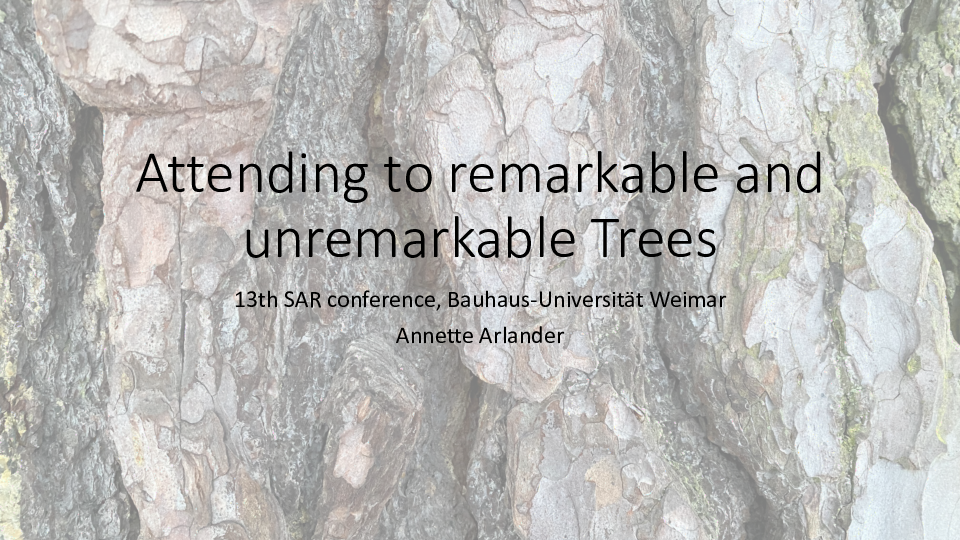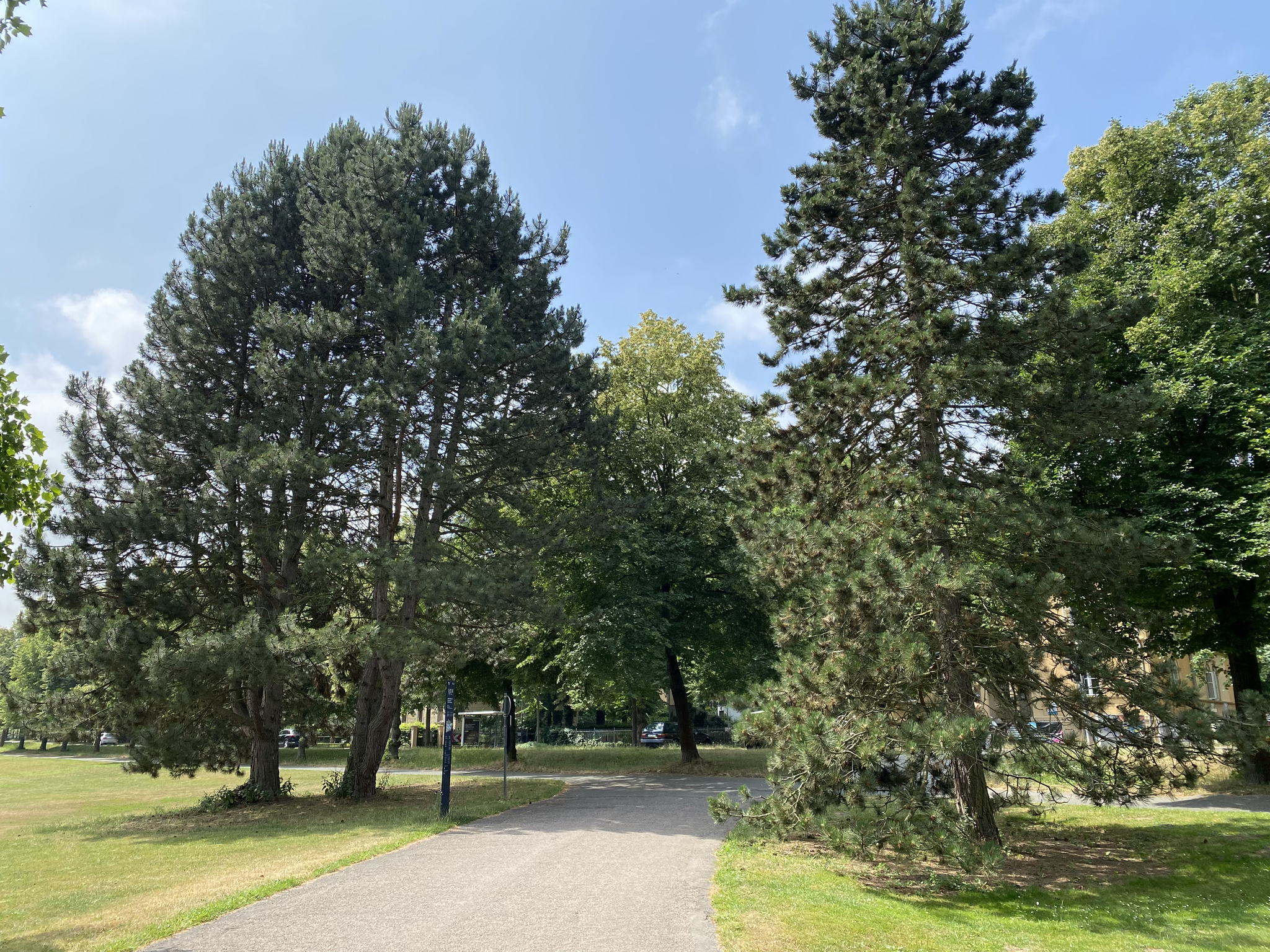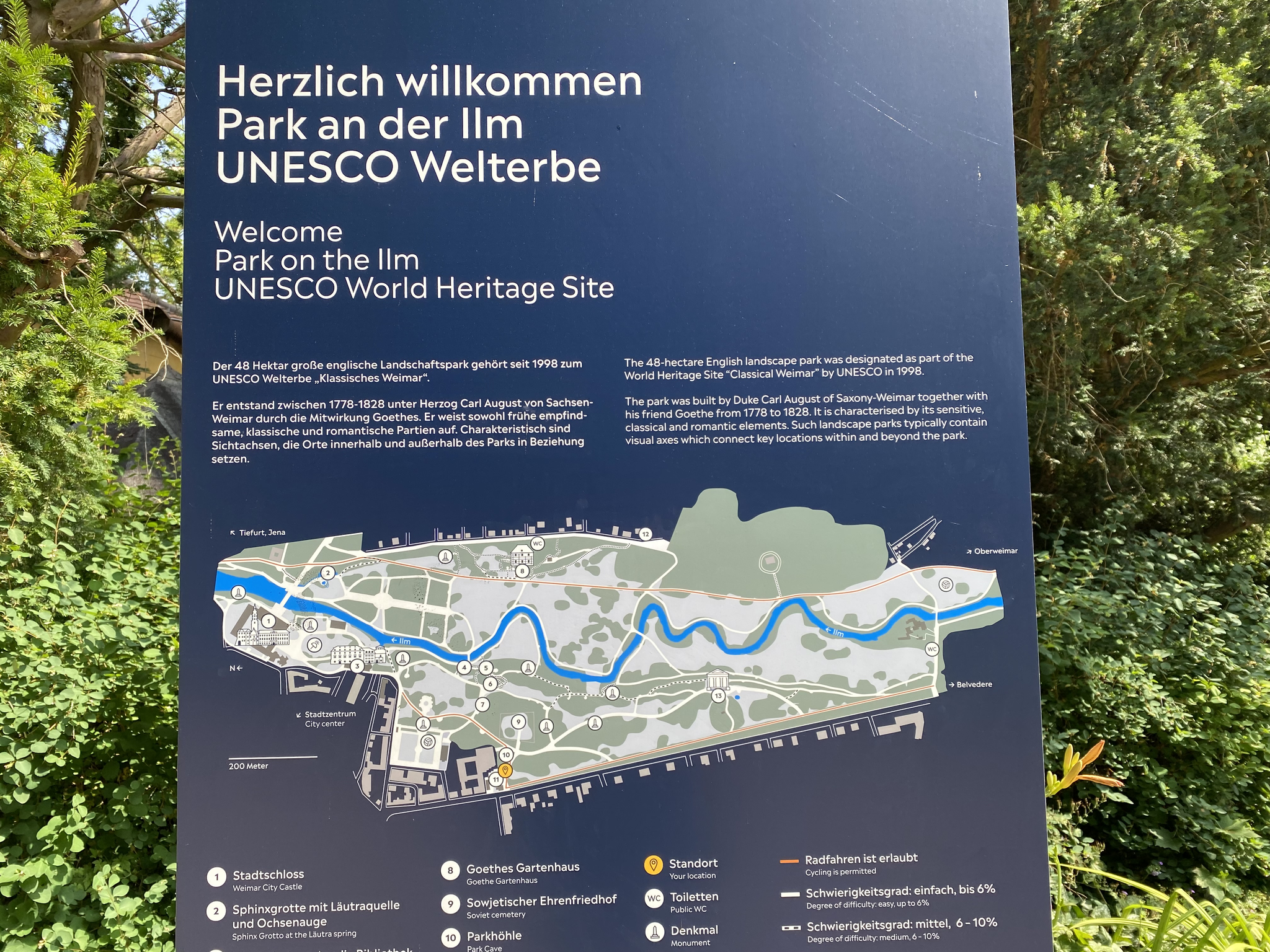|
A workshop during the 13th SAR (Society for Artistic Research conference) at the Bauhaus University in Weimar, Germany 30.6.-3.7.2022, see conference website
See the abstract in the program, here and through the bio in the programme here or below:
Attending, mending or blending? This workshop takes as its starting point the artistic research project Meetings with Remarkable and Unremarkable Trees in order to focus attention on trees in the immediate vicinity. Besides trying to mend our broken relationship to other beings that we share this world with and constantly blend with in trans-corporeal exchanges, these exercises in attention to trees with trees can be used as a creative tool to assist concentration and focus as well as a sense of embodied connection with the environment. The project is in its title referring to the photographic work of Thomas Pakenham, who in turn plays with the title of a book by Gurdjeff. The fields of critical plant studies and environmental post-humanities as well as the philosophical study of plant thinking and the scientific debates regarding plant intelligence seem like obvious contact points, although these fields are not necessarily welcoming this kind of practical artistic exploration. Meanwhile, developed in the border zone between performance art, environmental art and digital video or media art, the project is in some sense lacking a proper home base to contend with and to expand. Why is the human body there to attract attention from the trees? Where is the exploration of new technology and biological processes? What is the critical focus, the analytic disclosure, the intellectual paradox pointed at? On a deeper level this presentation therefore asks, prompted by the call: What artistic tradition, field or discipline should this practice actually connect to, what artistic forerunners should it reference? And what consequences would those choices have on the further development of the project? |
Links to previous explorations:
“Writing with Trees”, Proceedings of Carpa 7 – Elastic Writing in Artistic Researchedited by Pessi Parviainen, Nivel 17, see
https://nivel.teak.fi/carpa7/writing-with-trees/
“Dear Olive Tree.” Journal of Embodied Research, 4(2): 5 (19:40). 2021. DOI: https://doi.org/10.16995/jer.70
“Ask a Tree” for Designing the Pluriversity-project https://designingpluriversity.org/6-Annette-Arlander
Dear pine or dear cembra pine, if you are a cembra pine. I tried to address you in writing, but now I will make a new attempt to address you by talking to you directly. There is a lawn mower working around the trees. And I hope it won't come here, closer. If it does, then I will come to you later. But the reason I visit you here at the entrance of the park, Park an der Ilm if I pronounce the name correctly in Weimar, Germany, is a workshop that is going to take place here in a few days that I am supposed to facilitate. My initial idea was to simply make a version of a workshop I've done previously through online instructions, inviting people to go out to a park and find a tree that feels somehow inviting to them, and then address that tree or ask that tree for advice - as I ask you know - either related to their research or whatever problems they feel like wanting to consider together with the pine or the tree. Because of course, the important thing is that it's my obsession to focus on pine trees. The participants can choose any tree they like, which makes it easier because there are not many pine trees here, but a lot of all trees of all kinds. Very beautiful. But I'm what I'm wondering is how I should, how we should share what we have done? Should we share that, should I invite people to make representations of their encounters either drawings or poems or recordings or photographs or in some other manner, sort of, bring back something that represents or symbolises the encounter they have experienced? Because after all, that's what most artists do, they create some sort of representations or objects or traces or whatever. But on the other hand, it would be so very seducing, inviting to share the encounters by showing the trees for real if they are ... somewhere in the vicinity. I'm sitting next to the main street here because you grow here by the entrance, but probably people would choose their trees further in the park. So it might be quite a long walk to go and visit them all. I'm like in two minds. Of course a lot depends on the weather, too. Or should I stick to representations and invite people to create a page on the Research Catalogue, uploading the stuff there. Or sending the stuff to me so I could upload it as part of the conference proceedings somehow, or as part of my project. I wonder if people would be willing to do that or if it would be more interesting to share the walk. When I'm sitting here, under you next to the trunk, and despite the nettles growing here, which are not so inviting, it feels very boring to think of going back indoors, so. But on the other hand, there is a conference program that we should stick to so we cannot be late for that. Maybe I have to play it by the ear and react to circumstances. At least I can claim that is your advice. I'm not sure if that is an advice that you now give me or is it something that I just wish to hear? The idea that I should leave it open and decide on the spot. But anyway, thank you for assisting me in formulating these considerations by providing the shade and the support, if nothing else, so thank you and bye bye.
Saturday, second of July, quarter past three, or approximately quarter past three. Now we have started the workshop. There was an introduction in the room. And now all the participants have been sent away in the park to meet a tree and attend to that tree and perhaps represent that encounter in some manner. And I promised to stay here with you and wait for them when they come back, which is at the latest at four o'clock, so there is plenty of time, there is 45 minutes time to meet the tree and engage with that tree. I'm not going to talk with you, or record my talk with you for 45 minutes, I just wanted to make this note and to somehow also try to acknowledge that you helped me in deciding how to design this workshop, which is very simple. The only task is to go out and attend to a tree and then come back and share something of the encounter. So in that sense, if I would need to share something of our encounter, it could be this recording or this 'pondering'. But I also think that this is a good challenge to me to sit here with you, or stand here or walk around with you 45 minutes and try to listen to you rather than talk myself all the time. So that's what I'm going to do now. And maybe talk to you later. Thank you.
Saturday second of July approximately quarter to four. Now in 15 minutes people will start returning. And I've spent half an hour walking around your trunk slowly back and forth looking at your needles and your pine cones, both male and female, and also dry needles that remain sometimes in clusters but also all kinds of leaves or berries or things from other trees that the wind has just brought to your needles. And I realized that it might be quite uncomfortable to have all that rubbish hanging on you without being able to shake it off. I mean, not only your own dry needles, but anything that might land on you. Probably the wind will shake off some of the dead needles, especially higher up but on the low branches it's clear that needles from higher up have fallen and were meant to reach the ground but stayed on the lower branches now, as an extra weight but also preventing sun and water and air coming to the living fresh needles. Or I don't know. But if I approximate the human experience or extend it to others, then I wouldn't like having a lot of rubbish in my hair on my shoulders, or actually anything there. But that's not very much thinking as a result of 30 minutes of hanging around with you. But on the other hand is a pleasant place in your shade. So why not? So, thanks again. Enough for now. Bye.
Mend-Blend-Attend: Advancing Artistic Research, Proceedings of the 13th SAR International conference on Artistic Research
https://www.researchcatalogue.net/view/2429200/2429201






